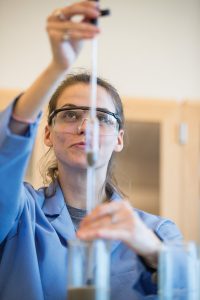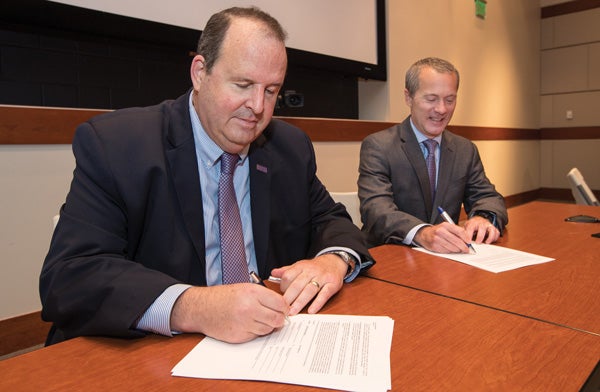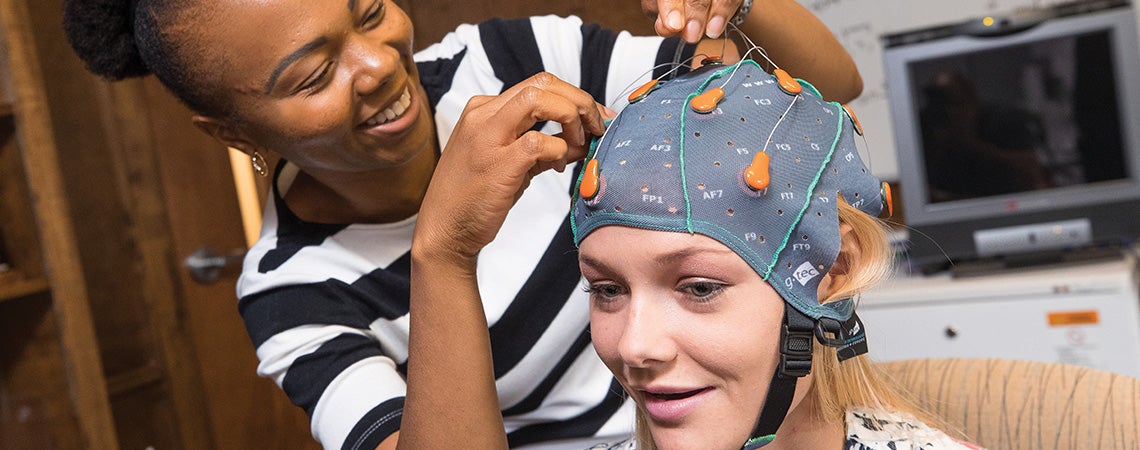Ideate, Investigate, Innovate
Not to mention educate and graduate

Elizabeth Mason studies sand at the Coastal Studies Institute.
East Carolina has been a place for new ideas for more than 100 years. And new ideas are what university leaders are hoping will help grow the university’s research enterprise in coming years.
One place that potential for growth is shown in black and white is the Higher Education Research and Development Survey’s annual list of U.S. colleges and universities in terms of their research funding and expenditures. ECU is on the list, but not where leaders want it to be.
“When you look at the list… of the top 100-150 of these institutions are institutions you think of as great national universities,” says Jay Golden, an engineer by training and ECU’s vice chancellor for research, economic development and engagement.
“It’s a benchmark.” Golden is the point person for Chancellor Cecil P. Staton’s goal of doubling ECU’s research awards and expenditures in the next five years. “From a research and engagement standpoint, we have room to grow,” Golden says.
“We have to step up our game in research. But the positive is we’re well-prepared. This university is going all in as far as financial, infrastructure and technical support,” he adds.
Research clusters
And one of the ways Golden plans to reach that goal is through the creation of research clusters – groups of scientists working together on a related issue.
“Smaller than a center, bigger than a collaboration,” is how Keith Keene, an assistant professor of biology, describes research clusters. He’s a co-director of the precision medicine cluster. “These clusters allow the research to develop organically.”
Golden says the clusters are a first step. Other steps are being intentional about research and engaging industry and community partners.
“We’re being very focused,” Golden says. He wants to find researchers who want to collaborate and create an organization that reduces administrative burden. “You can say it all you want, but it can’t happen unless you support it and focus on making it happen.”

Drs. Ian Woods, left, and David B. Leeser, chief of transplant surgery at ECU.
Brandon Morrison, director of strategic initiatives for the Division of Research, Economic Development and Engagement, said the unique challenges eastern North Carolina faces require an innovative, problem-solving approach.
“Innovation seldom originates from isolation,” Morrison says. “Bringing together a network of faculty and researchers with diverse backgrounds and interests spurs collaboration and joint research projects,” he says.
Adds Golden, “While we are focused on the STEM areas in research, ECU will be very focused in including arts and humanities in our research efforts.”
The research clusters also come with some new terms, such as “decision theater” and “collision space.” Put roughly, these are places where scientists, policymakers and industry representatives meet to hash out new approaches to solve problems and create opportunities.

ECU Vice Chancellor of Research, Economic Development and Engagement Professor Jay Golden, left, signs a memorandum of understanding with Shannon Lasater, senior consulting manager education practice with SAS Institute at the East Carolina Heart Institute.
Dr. David Collier is the other co-director of the precision medicine cluster. He sees the clusters as an organizing principle to focus research. In the case of his cluster, cancer therapies are the most likely target. Targeting specific gene mutations, precision medicine allows people with rare forms of cancer to be treated while also identifying people who would not benefit from the treatment. That saves time, money and the emotional distress of hoping something will help then finding out it won’t.
“Thinking outside the genetics box, understanding why some respond and others don’t, then developing therapies for the nonresponders,” he says.
As an example of professors from various fields working on a problem, chemistry faculty member Allison Danell has recently begun working with Collier on precision medicine.

A cannon from Blackbeard’s famed Queen Anne’s Revenge is raised out of a tank to be put on display.
Research clusters aren’t a new idea. Numerous universities have them, as do other organizations. Any formally recognized groups that apply their research expertise to a common area, field or theme or who are involved in a collaborative project or set of related projects can be called a research cluster.
One advantage is that while they can pursue different aims, together, their work can contribute to a single pursuit. In ECU’s case, one of those pursuits is the Rural Prosperity Initiative, announced in September. That project aims to find solutions to the disparities in health, education and economic development in rural and coastal North Carolina communities.
“ECU has been and will continue to be North Carolina’s rural university,” Golden says. “We have two times the number of undergraduate students from rural areas (as N.C. State and UNC-Chapel Hill). If we don’t do this, who will? And no one will do it better than us.”
2016 HERD SURVEY RESEARCH EXPENDITURES
ECU is in the top three among University of North Carolina system institutions in several categories, according to the National Science Foundation’s Higher Education Research and Development survey:
| PROGRAM | 2016 EXPENDITURES | UNC SYSTEM RANK |
|---|---|---|
| Health Sciences | $9.6M | 2 |
| Biological and Biomedical Sciences | $11M | 3 |
| Geological and Earth Sciences | $388,000 | 3 |
| Funding from Health and Human Services | $10M | 3 |
| Funding from Businesses | $2.4M | 3 |
| Life Sciences | $20.7M | 3 |
| Clinical Trials | $2M | 2 |
Big data and analytics
Leaders:
Leonard Annetta, education
Huigang Liang, business
Focus:
Bioproducts and bioenergy, health sciences, machine learning and innovative visualization.The cluster intends to house and analyze data that supports rural-based companies in conjunction with ECU’s recently announced partnership with analytics leader SAS.
Energy and natural resources
Leaders:
Burrell Montz, geography, planning and environment
Alex Manda, geological sciences
Focus:
Biogas and off-shore energy, including wave and wind-powered energy, water quality in eastern North Carolina, surface and groundwater management, wastewater management and storm water management.
Health behavior
Leaders:
Sam Sears, psychology
Kim Larson, nursing
Focus:
How behaviors create patterns that can be used to influence health decisions; adolescent risk behaviors, especially those that affect sexual risk, mental health and physical activity.
Human health and disease
Leaders:
Espen Spangenburg, physiology
Mark Mannie, microbiology
Focus:
Increase understanding of acute and chronic disease in the region, including obesity, diabetes, cardiovascular disease, stroke and cancers.
Marine and coastal
Leaders:
Reide Corbett, Coastal Studies Institute
David Griffith, anthropology
Focus:
Continental margin resources including non-renewable and renewable energy, cultural resources and biological resources; natural hazards including storms, saltwater intrusion and human vulnerability; and marine and coastal health including environmental and human health, health disparities and toxicology.
 STEM innovations
STEM innovations
Leaders:
Shawn Moore, education
Daniel Dickerson, education
Focus:
Teacher preparation and improvement, college workforce readiness and public understanding of STEAM (science, technology, engineering, arts, and math) content.
 Precision medicine
Precision medicine
Leaders:
Keith Keene, biology
David Collier, pediatrics
Focus:
How health care professionals can classify people into subgroups while providing optimal treatment options based on people’s susceptibility to a particular disease and their response to treatments.
Biomedical sciences and engineering
Leaders:
TBD
Focus:
TBD
“Innovation seldom originates from isolation. Bringing together a network of faculty and researchers with diverse backgrounds and interests spurs collaboration and joint research projects.”
Brandon Morrison, director of strategic initiatives for the Division of Research, Economic Development and Engagement
SAS leaders also say the partnership will help prepare more graduates for the marketplace.
Another partner is RTI International, the non-profit research institute headquartered in Research Triangle Park that is “dedicated to improving the human condition.”
“RTI is an internationally recognized leader for developing and implementing impactful research programs,” Golden says. “Our missions are similar in that we are focused on improving the human condition.”
Keene, the biology professor, has a succinct summary of ECU’s research outlook and the prospects for growth.
“It’s an exciting time to be a student or researcher or faculty member,” he says.






